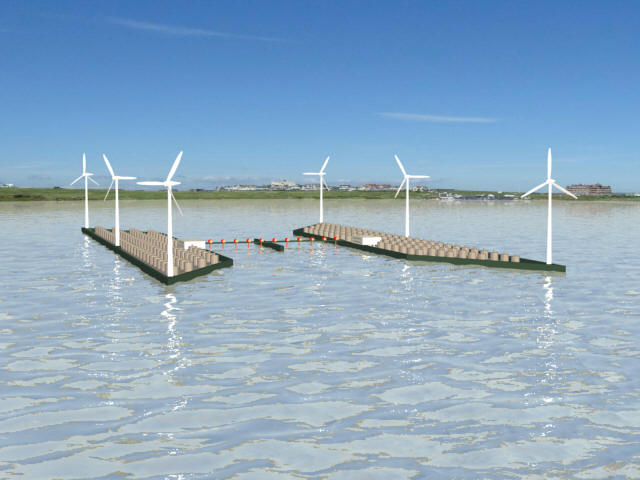Ocean Hydro Electric Generator (OHEG)
The OHEG is a revolutionary hybrid concept using the tide to produce energy. The power is produced by using both the kinetic energy in tidal flow and the potential energy created by tidal height changes, utilising offshore storage lagoons to retain the mass of water. The structure is fixed to the sea bed and the water velocity is increased by incorporating a venturi arrangement.
See below an artist impression of a 10MW system.

The OHEG concept is completely independent of the wind farm; however it does make an ideal foundation for offshore wind turbines, combining both tidal energy and wind energy. The concept is not detrimental to the surrounding environment or ecosystem and due to its offshore location it will not be visually offensive. Currently the project is on hold awaiting funding.
OHEG Flow Diagram
The Flow Diagram shows the three power generating systems used in the concept;
- “Tidal Turbines” – located within the main channel.
- “Chamber Turbines” – located within the walls of the lagoon.
- “Accumulators” – located within the lagoons.
The flow diagram shows power being transmitted to the generator through a balancing system, containing a compression vessel and header tank, this ensures that the generator receives a constant supply of hydraulic pressure throughout the whole tidal sequence. Automated valves, hydraulic motor and gearbox have been omitted for clarity.

The tide floods into the channel, increasing in velocity as it flows through the venturi inlet. This drives the tidal turbines, creating a hydraulic pressure in the system which feeds the compression vessel. The compression vessel in turn feeds the generator.

As the tidal turbines stop producing power, the lagoon turbines are opened, allowing water to flood into the lagoons. The hydrostatic head drives the lagoon turbines as the water flows into the lagoons. The accumulators are submerged, locked into position by the hydraulic cylinders.

As the lagoon turbines stop producing power the accumulators are allowed to rise. Lagoon turbines are closed, trapping water within the lagoons. The upward buoyancy force acting on the accumulator creates power in the downward facing cylinders. The upward facing cylinders recharge with hydraulic fluid, which is drawn from the header tank. As the accumulator reaches the top of its stroke the tide begins to ebb and the process repeats itself in reverse, starting with the tidal turbines.
